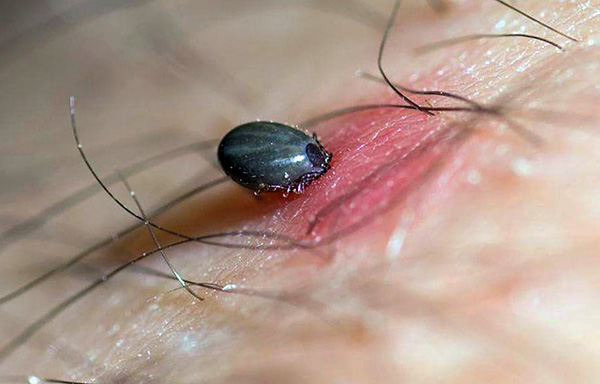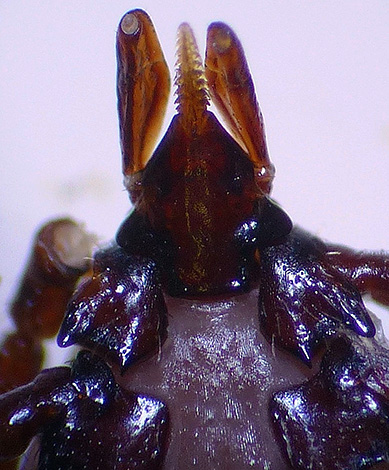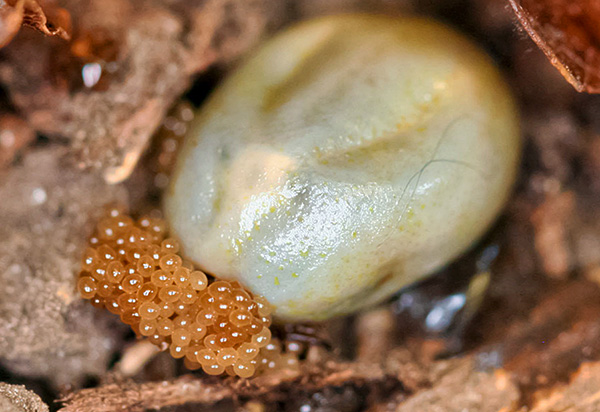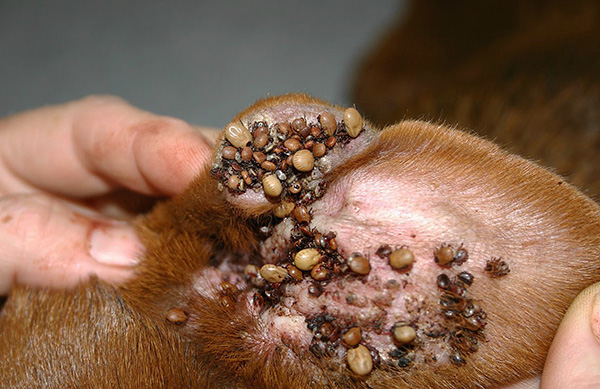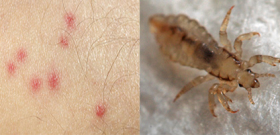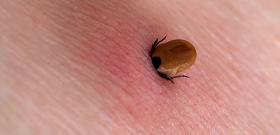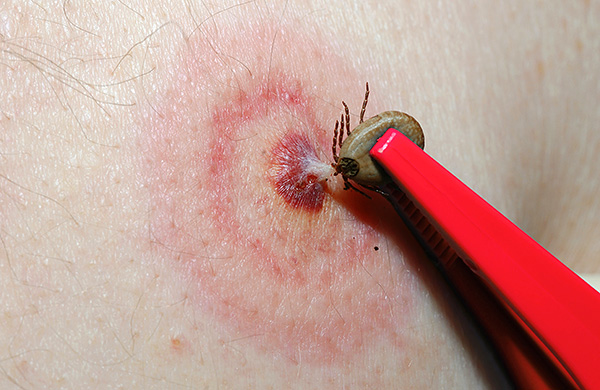
We note right away that it can be quite difficult to unambiguously identify a tick bite without finding the parasite itself on the body. The fact is that the reaction of the body to a puncture of the skin by ixodides is approximately the same as that to the bites of various blood-sucking insects, and the external signs of tick bites and other bloodsuckers are generally similar.
For example, the photo below shows what the bite of a taiga tick looks like on human skin:

And here is a midge bite:

As you can see, in appearance, the bite marks in this case do not differ much.
Nevertheless, taking into account individual details in the appearance of tick bites on the human body makes it possible to distinguish them from the bites of other arthropods with a certain accuracy. Knowledge of the characteristics of the biology of ixodid ticks, including the specifics of their attacks on animals and people, also helps to distinguish between bites.
All these nuances will be discussed in more detail later. including situations where, by the appearance of the wound, it is already possible to speak with a high probability of infection with a dangerous tick-borne infection.
What does a tick bite look like in most cases?
In most cases, a tick bite looks like a clearly visible spot with redness, in the center of which there is a wound with a diameter of about 1-2 mm. The photo below shows examples from which it is clear why the wound turns out to be relatively large (the head of the parasite is literally completely immersed under the skin):


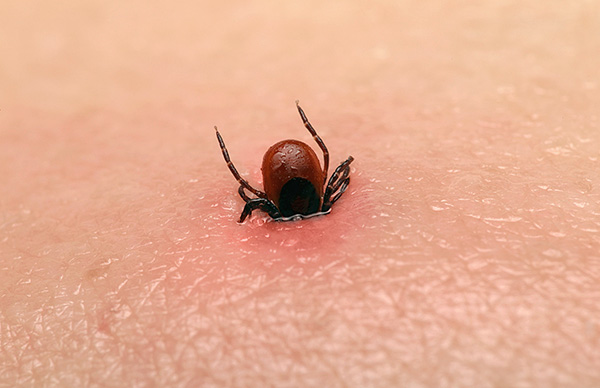
The wound caused by a puncture of the skin, within an hour after detachment of the tick, is covered with a crust, while some swelling and redness persist.
On a note
It is a clearly visible wound in the center of the bite that is an important distinguishing feature of tick bites. In many other parasites, the bloodsucking organs are so thin proboscis that practically no traces remain from piercing the skin with them. In ticks, the mouth organs are also quite large, and the method of feeding requires the formation of a relatively large hole in the skin of the host.
In the ordinary case, the next day the bite site no longer itchs, after 2-3 days the swelling and redness subside, and after a few days the crust at the site of the wound peels off.
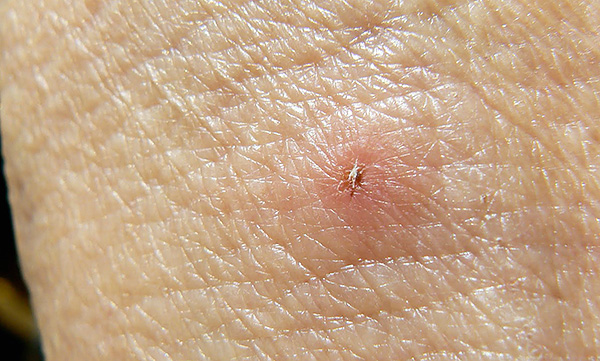
After about 10-12 days, no trace remains at the site of the tick bite.
This happens normally, when infection does not occur in the bite wound and the inflammatory process does not develop, and the wound itself is not disturbed, combed and does not damage the protective crust on it. However, often due to various undesirable factors, the situation can be complicated, which is accompanied by the appearance of additional unpleasant symptoms.
For example, if a sucking tick is incorrectly torn off the skin, even if the parasite remains unharmed (that is, no parts of its body remain in the wound), a dense bump often forms around the bite site, which is very itchy. This is due to tissue injury by roughly pulling out the oral organs of the bloodsucker, literally glued to the skin with a case of frozen saliva.
Besides:
- When extracting the parasite with fingers, excessive pressure on the body leads to squeezing out additional portions of saliva into the wound;

- Due to itching, the resulting lump is usually scratched strongly, which further increases the itching, contributes to the spread of redness, and can provoke infection and further suppuration of the bite site.
If the lump is lubricated in time with an anesthetic ointment and not disturbed, then it gradually decreases in size and completely subsides after 4-5 days.
A more dangerous situation is when, when the tick is pulled out, its body is torn off from the head (gnathosoma), as a result of which the mouth organs remain in the wound. It is not always easy to remove them from here, since it is difficult to capture them even with tweezers or tweezers from a manicure set - the tick gnathosoma is deeply immersed in the skin, and the rupture of its body usually occurs deeper than the level of the very surface of the skin.
In this case, in addition to a spot of redness, a noticeable black dot remains at the site of the bite - the very mouth organs of the parasite.
If the detached head of the tick is not removed, like a splinter, on the second or third day, the tissues at the site of the bite will begin to boil, an abscess will form here, from which the remnants of the tick will later come out along with the outflowing pus.

Often a painful abscess with swelling is formed. From the moment of detachment of the tick to the rupture of the abscess and the expiration of pus from it, an average of 3-4 days pass, for a few more days the site of the abscess will heal.
When the parasite is carefully twisted using special tick removal tools, approximately the same wound and swelling remain at the attachment site, which occur when the parasite detaches itself.
The picture below shows the sequence of correct twisting of the tick:
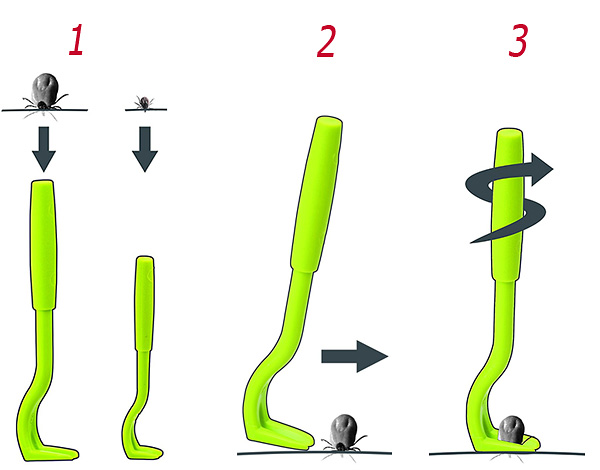
And here are photos with examples of tick removal using various tick grinders:
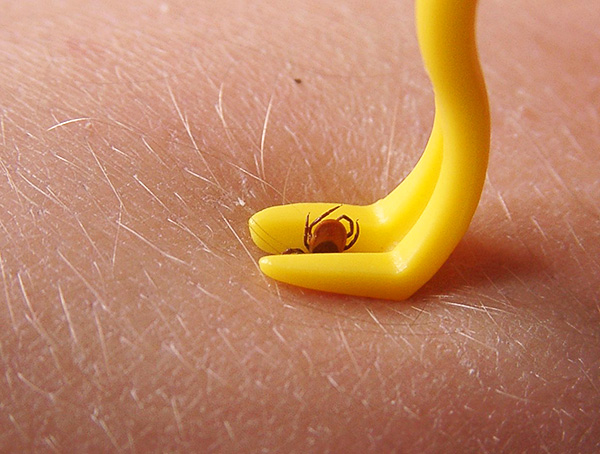
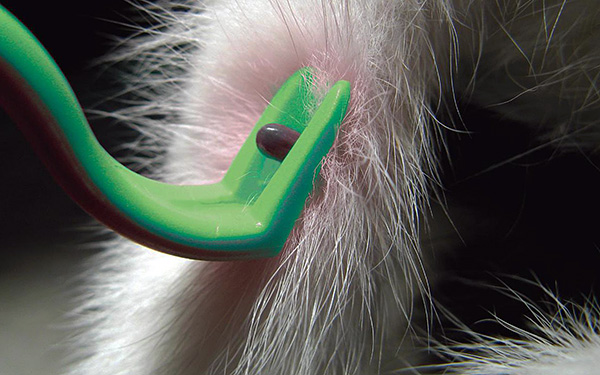

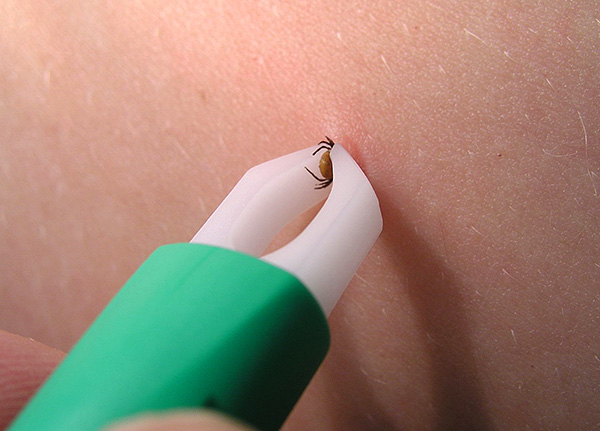
On a note
It should be borne in mind that if contamination enters the wound, its bacterial infection may become a consequence. Therefore, the site of the tick bite immediately after removing the attached parasite should be disinfected - for example, with "green" or an alcoholic solution of iodine. It is only important to understand that this does not affect the likelihood of developing tick-borne encephalitis or borreliosis (if the tick was a carrier of the corresponding pathogens), but helps to prevent only the undesirable development of a secondary bacterial infection in the wound.
In general, a tick bite can be described as mildly painful, itchy, accompanied by redness and swelling, but most importantly, hardly noticeable until the parasite is detached. While the tick is attached to the skin and sucks blood, the person practically does not feel it.
As noted above, if the parasite has already unhooked from the skin, it will be difficult to understand only by the appearance of the bite that it was just a tick. Often, according to certain signs, it is easier to understand that the bite was definitely left not by a tick, but by another arthropod.
How these parasites don't bite
In all cases, ixodid ticks bite only to suck on blood. They never attack a person in self-defense.
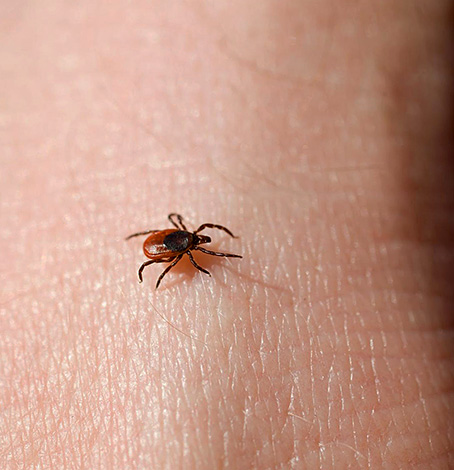
Besides:
- A tick bite is never extremely painful, never causes acute throbbing pain, does not "burn". All these signs are characteristic of the bites of arthropods, which in this way try to protect themselves or their nests and scare away a person, first of all, with acute pain during a bite (bees, wasps, scorpions, etc.);
- The tick does not bite quickly and does not run away quickly from the bite site.It takes a long time for the parasite to choose the optimal place for sucking, and even more time is required for bloodsucking. That is, if a person examined a part of the body a minute ago, and there was no parasite on it, and then a few minutes later a bite appeared in the same area, but the bloodsucker is not visible, which means that it was definitely not a tick that bit;
- The tick does not severely injure a person with a bite; blood does not ooze from the wound left by it;
- With rare exceptions, tick bites do not cause a rapid generalized reaction. During the first 1-2 days after the bite, headaches, fainting, heart failure, nausea and deterioration do not develop. Such symptoms may indeed occur later with the development of an infectious disease transmitted by a tick, but not earlier than after a few days of the incubation period (usually this takes several weeks). If such signs appeared in the first hours after the bite was detected, then it was not a tick that bit.
On a note
An exception to the latter rule are bites from the Australian paralyzing tick Ixodes holocyclus. Its individuals at all stages of their development secrete a toxin with saliva, leading to paralysis of the limbs in animals and humans, as well as symptoms similar to those of poliomyelitis (a fatal outcome is also possible). The first signs of paralysis after the bites of these ticks appear after 6-7 hours. The species Ixodes holocyclus lives only in Australia, and in Eurasia such situations are excluded.
Photo of the paralyzing tick Ixodes holocyclus:
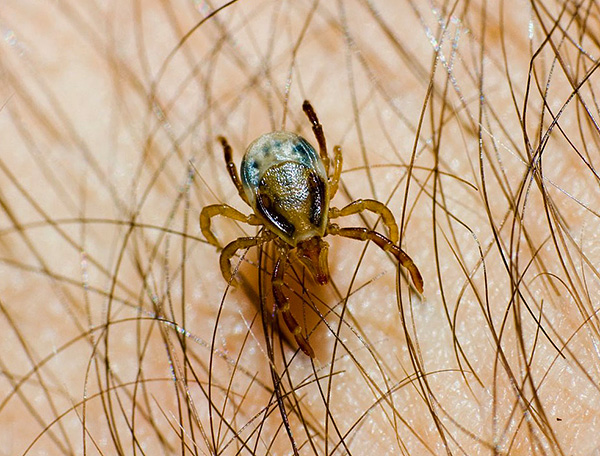
Another important sign: ticks never bite through clothes, even through very thin clothes. (through pantyhose, for example).Mosquitoes, midges, horseflies, spiders can bite through thin fabrics, wasps and bees can sting, but ticks never stick to the skin through clothing.
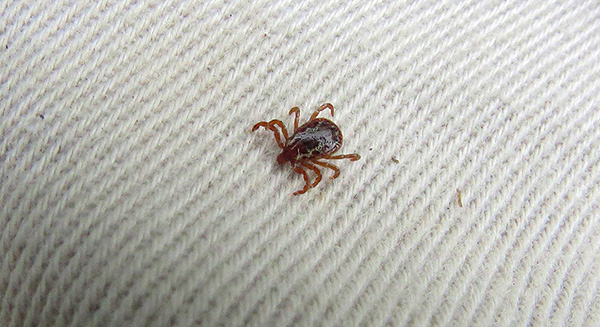
At the same time, under loose clothing - under wide trousers, shirts, T-shirts, behind the head under a hat - a tick may well bite.
Differences between a tick bite and the bites of various insects
We have already said about the first important difference earlier: a red spot and a clearly visible wound remain at the site of the tick bite, gradually crusting over. This is in contrast to mosquito bites, in which only an itchy swelling remains, but without a visible insertion site of the proboscis.

From the bites of most stinging insects, spiders and centipedes, tick bites are completely painless. Even mosquitoes that inject anesthetics into the wound do not do it so “skillfully”, and their injection immediately attracts attention with slight pain.
From the bites of bed bugs (and to some extent fleas), tick bites differ in that they are not collected in “paths” of 2-3 wounds. Each bug bites several times in one attack, moving between bites by 1-2 centimeters, and as a result, characteristic “chains” of reddened bumps remain on the human body. The tick bites only once, after which it falls away from the body, and therefore leaves only one trace of a skin puncture on the skin.
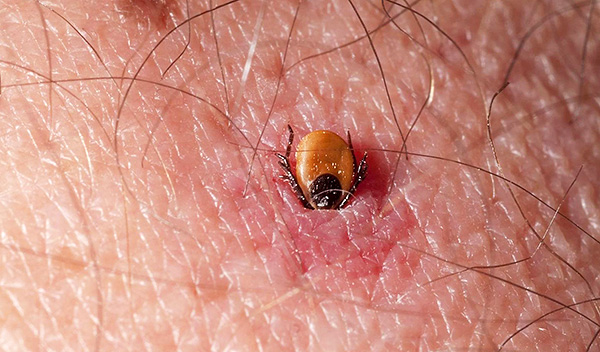
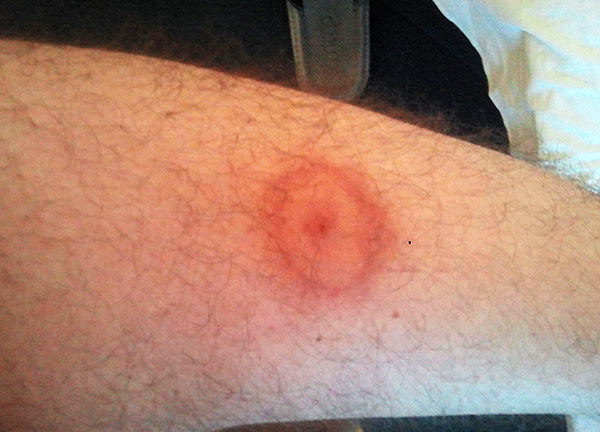
On a note
It is easy enough to distinguish a tick bite from a bite of a centipede, a tarantula or a small poisonous snake: these animals leave two points at once at the skin puncture sites. Centipedes bite with two well-marked jaws, spiders with two chelicerae, snakes with two teeth.Consequently, there will be two well-marked points in the places of their bites. The tick pierces the skin with a sawtooth hypostome in only one place.
By the shape of the wound itself, a tick bite can be distinguished from a leech bite. After sucking a leech, due to the characteristic structure of its oral apparatus, the wound looks like a small even cross. In a tick, it just looks like a dot. After the leech falls off, the wound bleeds for a very long time, which does not happen after tick bites.
An important characteristic difference between a tick bite and the bites of any other parasites is the development of annular migratory erythema when infected with Lyme borreliosis. Such erythema is a clearly visible red ring around the bite site, gradually expanding and spreading over the skin (see examples in the photo below).
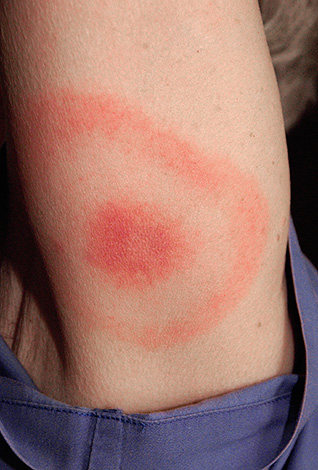
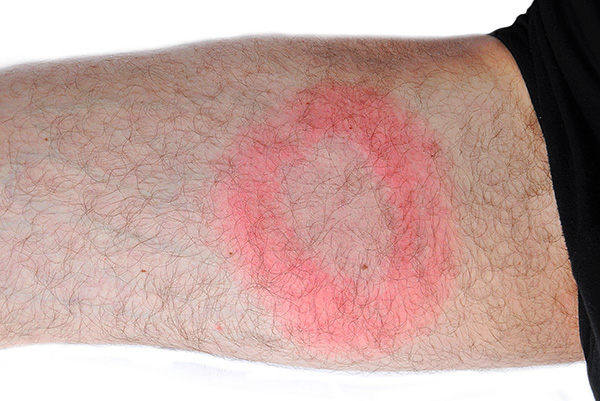
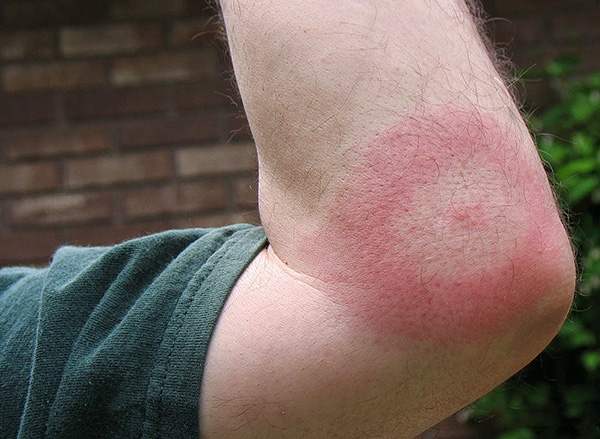
After the bites of any other parasite, such a formation does not appear. Depending on the duration of the incubation period of the disease in a particular person, erythema migrans occurs at different times - from several days to several months after the bite.
But to judge the infection of a person with the tick-borne encephalitis virus by the appearance of the bite will not work - outwardly this does not manifest itself in any way.
Finally, the main feature that distinguishes tick bites from the bites of other blood-sucking or stinging arthropods: the tick always sucks blood for a long time. Even larvae and nymphs of the first instars, which require relatively little food, stick for at least a few days, and adult females, sucking the largest amount of blood, stay on the skin for more than a week. Therefore, in most cases, the attached parasite is found on the human body even before its detachment.

Reverse situations happen very rarely - they can occur, for example, on a multi-day hunting or fishing trip, on hiking trips, that is, during a long stay in the wild without the opportunity to undress, wash and inspect the body. Here, a tick can suck blood from a person under clothing for several days, after which it will unhook.
This means that in a situation where, after a 2-3 hour walk in a park or in a forest, a person found some kind of bite, but the parasite itself could not be found, this bite was not left by a tick.
What happens when a parasite is sucked in
Ixodid ticks bite exclusively to feed on blood - this is their only food source. To saturate the parasite needs:
- Cling to the clothes or hair of the victim;
- Get to a place convenient for bloodsucking;
- Pierce the skin and gain a foothold in the wound;
- suck blood;
- Detach and leave the host's body.

It is important to understand that there are almost never situations in which a tick has bitten, but did not have time to stick and crawled away.
In general, finding a host and fixing it in its skin is a complex process. Typically, the tick is found at the top of a grass stalk with its front pair of legs forward. When a person or animal approaches, the parasite instantly grabs onto the host.

Then, from 2-3 minutes to an hour, the tick moves through the host's body and looks for well-blooded places with thin skin. Then comes the bite:
- The parasite spreads the palps to the sides, which at the usual time play the role of a "sheath" and close the hypostome;

- Hypostome and chelicera cuts through the skin;
- It secretes saliva into the wound, which contains many functional components (this includes anticoagulants that prevent blood clotting and thickening, painkillers, compounds that envelop the hypostome and partially spread in the intercellular space, gradually harden and form a kind of case that holds the parasite very securely in the skin );
- Then the tick begins to suck blood, lymph and inflammatory infiltrate from the wound.
The photo below shows the proboscis (hypostome) of a tick:
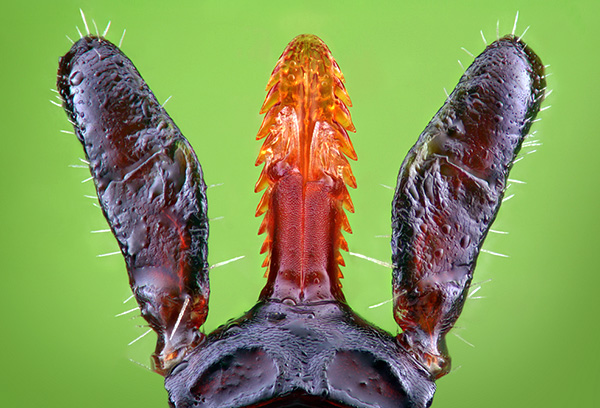
And this is what a hypostome looks like under a scanning electron microscope:
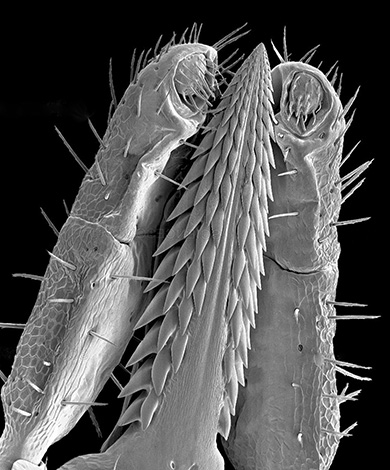
Representatives of different types of ticks and individuals at different stages of their life cycle tend to choose different places on the body of the host for attachment. On the human body, these are most often the areas of the armpits, and then, in decreasing frequency of attachment, the following areas follow:
- Breast;
- Stomach;
- Hands (including between fingers);
- Buttocks and perianal area;
- Groin;
- Legs;
- Neck and head (especially the area behind the ears).
The photo below shows a tick stuck behind the ear of a child:
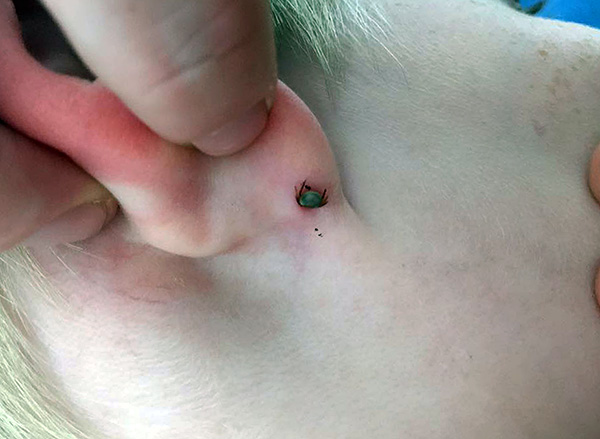
And here the parasite dug into the throat:
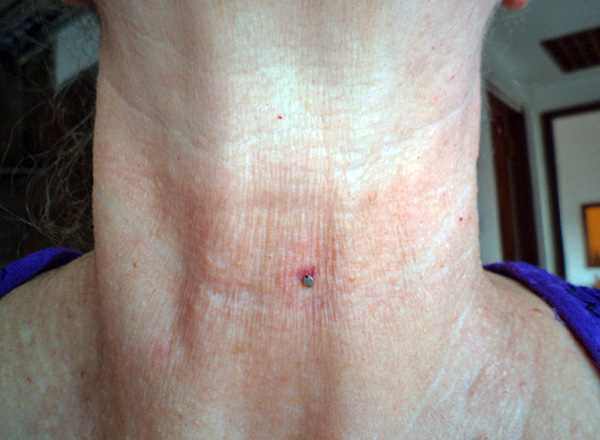
It is noteworthy that in children, more often than in adults, ticks are attached to the head (including in the hairline, more often behind the ear) and sometimes even on the face - on the cheeks, on the chin.
At the same time, the areas of attachment are largely determined by how a person is dressed. If, for example, his whole body is covered with thick clothing, then the parasite from the legs can reach the head and stick here.
The duration of bloodsucking depends on the sex of the parasite and the stage of its development. Thus, tick nymphs of all ages feed at each stage of their development for 3-6 days, and female nymphs - on average, a day longer than male ones.Adult males feed about the same amount - 3-6 days, and adult females - on average from 8 to 14 days.
It is interesting
Some types of ticks can eat both much less and much more time. For example, the larvae of Haemaphysalis kitaokai feed within 2-3 hours, while the females of Geochelone pardalis, which parasitize turtles, disappear on average only 60 days after attachment.
It is noteworthy that during feeding, the tick does not constantly suck blood. Short acts of sucking are replaced by periods of rest, then by injection of another portion of saliva into the wound. Studies have shown that no more than 15% of the time is spent directly on blood sucking while the parasite is attached to the host. This indicates a certain primitiveness of this method of feeding and to a certain extent reduces the survival rate of feeding ticks.
The photos below show female ticks fed on blood:
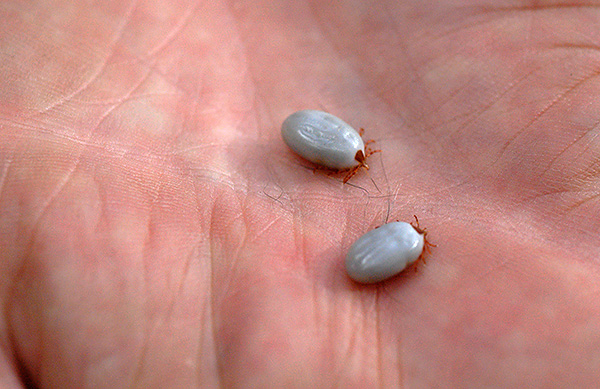
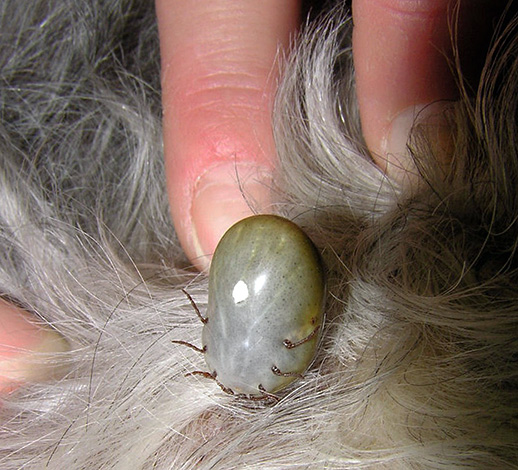
During the entire period of bloodsucking, the parasite not only fills the digestive tract with blood and inflammatory infiltrate of the host, but also actively grows and develops at the same time. In nymphs, it is at this time that the rapid development of internal organs and the growth of body integument occurs, and in adult males and females, the maturation of the reproductive system.
Therefore, by the way, in one feeding, each tick sucks out more blood and other fluids than it weighs at the time of detachment. For several days of feeding on the host, most of the food consumed has time to be digested and spent on development and growth, and undigested components are excreted with excrement.As a result, female ticks weighing 7-10 mg before feeding absorb about 5500-8500 mg of food during attachment, but weigh only 900-1400 mg after falling off.
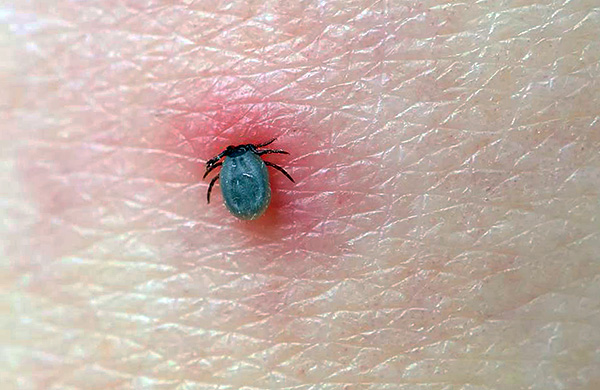
It is interesting
Virtually no environmental factors are able to force an unsatisfied tick to detach from the host. The fact is that the very fact of getting on the body of the owner and fixing on it is a vital necessity for each individual. So, one female lays several thousand eggs, and not all of them are fertilized, and only a part of them hatch larvae.
Of the several thousand larvae, only a few will be able to find the first host, and all the rest will die either from hunger or from predators. Similarly, out of several thousand larvae that have molted into the first instar nymph, only a few will be able to feed on the next host. As a result, for one adult tick attached to a person or animal, there are millions of its dead counterparts who failed to do so. Therefore, it is biologically so determined that if a tick has stuck, then it will detach itself only after saturation, and it is impossible to make it do this earlier. He would rather die than miss the chance to get enough to the end.
It is for this reason that methods for removing stuck ticks with hot matches, oil or repellents are ineffective. Even being burned or suffocating under a drop of oil, the tick will not let go of its prey.
If the tick is satiated, it independently removes the gnathosoma from the skin. What will happen to him next depends on the type of parasite and the stage of development of the individual:
- At one and two-term ticks nymphs and larvae can remain on the body of the host, molt here, and after the transition to the next age, stick again.This occurs most often when parasitizing on cattle;
- Adult males of some species, after detachment, go to look for females attached to the same host in order to copulate with them. The photo below shows a lot of sucking mites of different ages in the ear of a dog;

- In three-host species, after each saturation, the larvae and nymphs fall away from the host, seek secluded shelters in the ground and under stones, where they molt, and sometimes hibernate, and then go in search of new hosts;
- Adult females of all species fall off after satiation and hide in random shelters on the ground. Here they wait for the full maturation of eggs and lay them, after which they die.
Interestingly, while in nymphs of all ages, larvae and adult males, nutrition contributes to the overall development of the organism, then in adult females, when feeding, the reproductive system first fully matures, and after fertilization, the digestive system begins to degrade with the parallel development of a large number of eggs. In fact, after full saturation and development, an adult female is a living bag of eggs, practically incapable of further life. She can still move a short distance to find shelter on the ground, but here, after laying her eggs, only the mouth organs and the shell of the idiosoma are actually left of her.

Adult males also do not live long after feeding, but their life is a little more eventful. They actively search for females, fertilize them, and can feed several times. However, engorged adult males no longer survive the change of seasons and do not survive until the next year.
Possible consequences of an attack by ixodid ticks
Tick bites can lead to consequences that differ both in their external manifestations and in danger to the health and life of the victim.
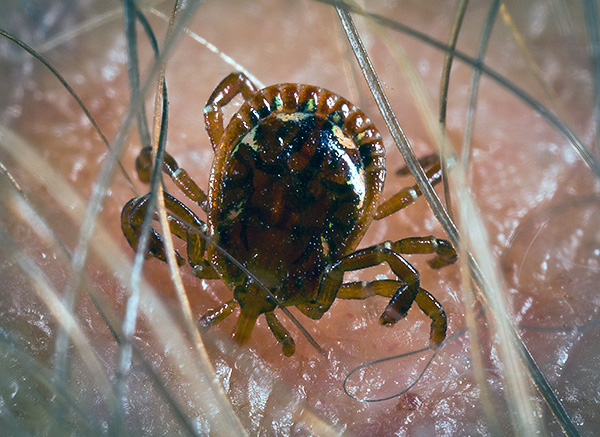
If we talk about bites in humans, then these consequences include:
- A normal temporary reaction to a bite is redness and slight itching after the tick detaches;
- Inflammation and suppuration of the wound, in which there was an accidental infection or the head of the tick remained after its removal;
- An allergic reaction, usually limited to swelling, spreading redness over the skin, and a rash around the bite site. Anaphylaxis in response to bites taiga and canine ticks not documented;
- Infection with dangerous tick-borne infections. In Russia and neighboring countries, such infections include tick-borne encephalitis virus and Lyme disease (borreliosis); in other countries, ticks can carry pathogens of spotted fever and Q fever.
Pets become infected from ticks with piroplasmosis, ehrlichiosis, hepatozoonosis and other diseases. Wildlife and cattle on heavily infested pastures can die of malnutrition if they are parasitized by too many ticks.
If the tick is infected with a particular infection, transmission of the pathogen begins almost immediately after cutting through the skin, when the parasite injects the first portion of saliva into the wound. The longer the tick feeds, the more infected saliva it passes on to the host, and the more likely it is to develop an infection later.
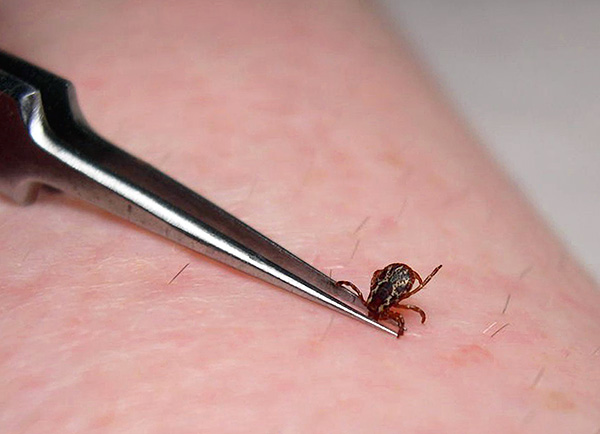
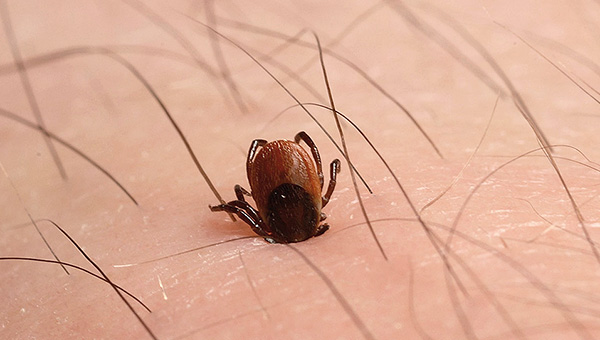
Of the two most common tick-borne infections in Eurasia, encephalitis is considered much more dangerous than borreliosis, since there is no specific effective treatment against TBE. Borreliosis, with timely diagnosis, is quickly and effectively treated with available antibiotics.
At the same time, even in the most dangerous areas for tick-borne encephalitis, the frequency of infection with this disease does not exceed 0.24% of the total number of bites. That is, out of 10,000 tick bites, only 24 of those bitten develop tick-borne encephalitis.
Is it possible to understand by the appearance of the bite that an infection has occurred?
By the appearance of the tick, it is impossible to determine is he infected, just as it is impossible to understand by the bite itself whether the transmission of the pathogen has occurred. Immediately after the bite and immediately after it, tick-borne infections do not manifest themselves in any way, therefore, they do not affect the appearance of the wound in any way.
On a note
As noted above, annular migratory erythema may appear after a few days, which is a sign of infection with borreliosis.
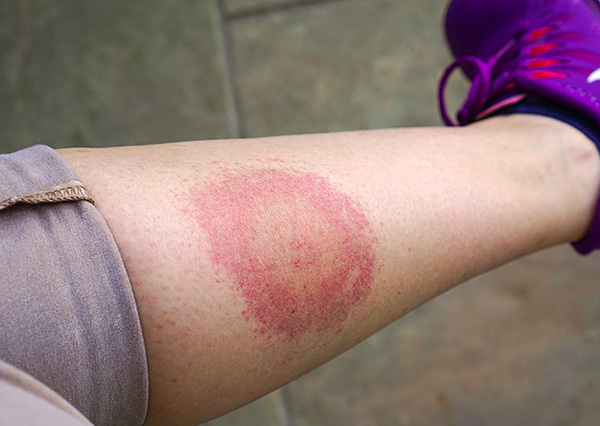
The first symptoms of encephalitis and borreliosis develop on average after 2-3 weeks, but sometimes incubation period may be different. So, borreliosis sometimes manifests itself already 4-5 days after the bite, and in other cases, the development of the infection is delayed for several weeks. Therefore, a bitten person needs to remember about the bite itself, so that when the first signs of the disease appear, immediately consult a doctor.
Some more photos
The tick stuck over the ear of the child:
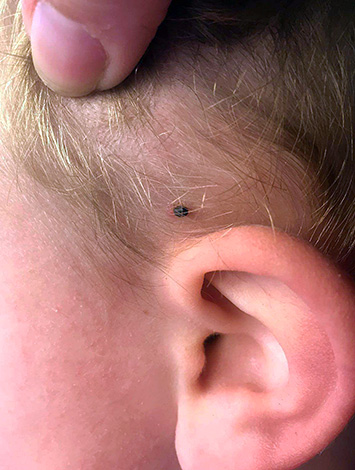
And in this photo you can see signs of an allergy to a tick bite:
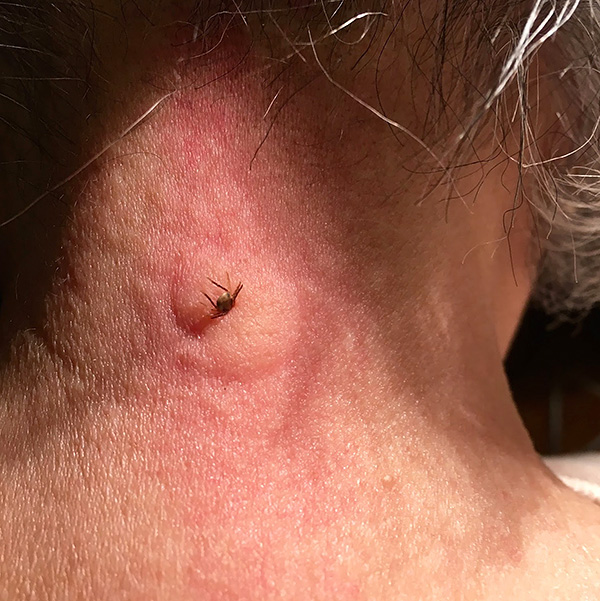
Removing a tick with a thread:
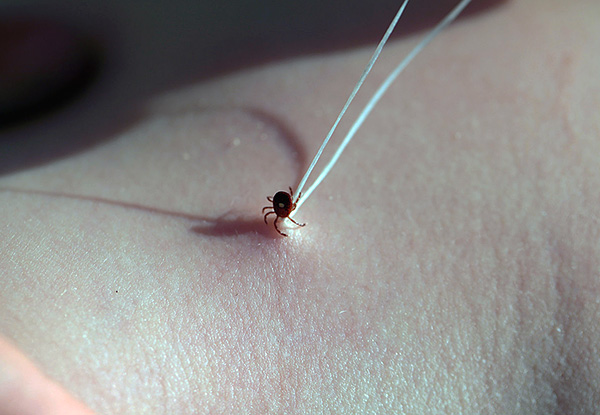
Interestingly, ixodid ticks parasitize not only warm-blooded animals, but also reptiles:
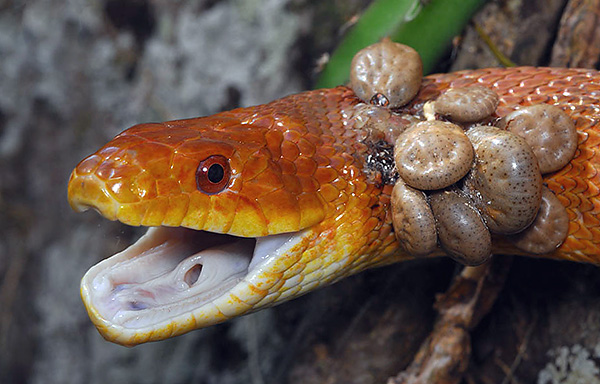
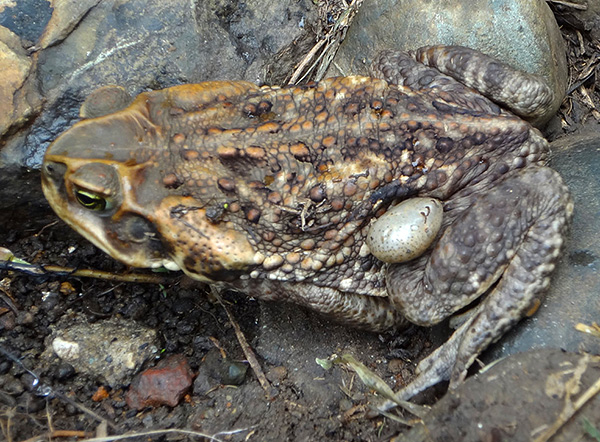
What to do next
In most cases, treating a bite with antiseptics is sufficient for first aid to the bitten.If the bite occurred in a region that is epidemiologically dangerous for tick-borne encephalitis, it is highly desirable to keep the tick for analysis, as this will help to find out if there is a risk of infection after the incident.
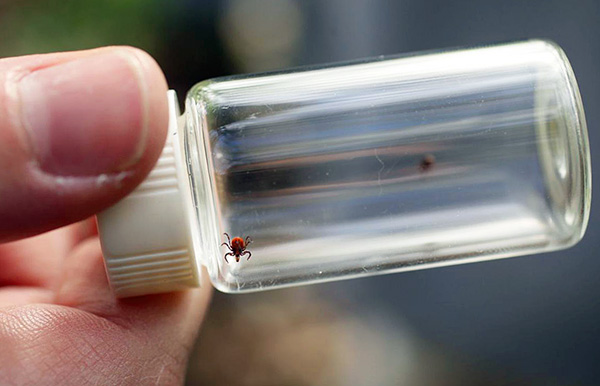
For this you need:
- Deliver the parasite to the laboratory, where it can be tested for infection with the tick-borne encephalitis virus. If the bite occurred in a region unfavorable for EC, the victim will be given emergency prophylaxis by introducing immunoglobulin against tick-borne encephalitis, and in two weeks it will be necessary to additionally donate blood for analysis. This is all relevant if the victim does not have vaccinations against TBE;
- If it is impossible to deliver the tick to the laboratory, you need to carefully monitor the condition of the bitten person for at least 4 weeks, remembering the date of the bite. If the slightest signs of the disease appear - an increase in body temperature, pain in the head, disorders of the nervous system - the bitten person must be immediately taken to the hospital for diagnosis and treatment.
On a note
As for pets, the incubation period for piroplasmosis is on average 1-2 weeks, and if at this time the pet shows signs of illness, it should be immediately taken to the veterinarian.
You do not need to drink any medications on your own and start any treatment after a tick bite. None of the tick infections can be treated at home. Only doctors prescribe and carry out such treatment.
Interesting video: what a tick bite can lead to

